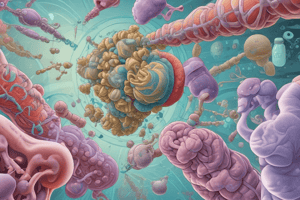Podcast
Questions and Answers
What is the main purpose of antibiotics?
What is the main purpose of antibiotics?
- To treat fungal infections
- To treat bacterial infections (correct)
- To treat viral infections
- To treat parasitic infections
What type of antibiotics kill bacteria directly?
What type of antibiotics kill bacteria directly?
- Broad-spectrum antibiotics
- Bacteriostatic antibiotics
- Bactericidal antibiotics (correct)
- Narrow-spectrum antibiotics
Which mechanism of action involves interfering with bacterial cell wall formation?
Which mechanism of action involves interfering with bacterial cell wall formation?
- Inhibition of protein synthesis
- Inhibition of cell wall formation (correct)
- Inhibition of metabolism
- Inhibition of DNA replication
What is antibiotic resistance?
What is antibiotic resistance?
What is an example of inappropriate use of antibiotics?
What is an example of inappropriate use of antibiotics?
What is a common side effect of antibiotics?
What is a common side effect of antibiotics?
What can increase the risk of side effects or reduce the effectiveness of antibiotics?
What can increase the risk of side effects or reduce the effectiveness of antibiotics?
Why is it important to complete the full treatment course of antibiotics?
Why is it important to complete the full treatment course of antibiotics?
Flashcards are hidden until you start studying
Study Notes
What are Antibiotics?
- Antibiotics are a type of antimicrobial drug used to treat bacterial infections
- They work by either killing or inhibiting the growth of microorganisms
- Antibiotics are ineffective against viral infections and fungal infections
Types of Antibiotics
- Bactericidal antibiotics: kill bacteria directly (e.g., penicillin, ampicillin)
- Bacteriostatic antibiotics: inhibit bacterial growth without killing them (e.g., tetracycline, erythromycin)
- Broad-spectrum antibiotics: effective against a wide range of bacteria (e.g., amoxicillin, ciprofloxacin)
- Narrow-spectrum antibiotics: effective against a specific type of bacteria (e.g., vancomycin, metronidazole)
Mechanisms of Action
- Inhibition of cell wall formation: interfere with bacterial cell wall formation (e.g., penicillin, ampicillin)
- Inhibition of protein synthesis: interfere with bacterial protein synthesis (e.g., tetracycline, erythromycin)
- Inhibition of DNA replication: interfere with bacterial DNA replication (e.g., ciprofloxacin, norfloxacin)
Antibiotic Resistance
- Definition: the ability of bacteria to resist the effects of antibiotics
- Causes: overuse and misuse of antibiotics, genetic mutation, and horizontal gene transfer
- Consequences: reduced effectiveness of antibiotics, increased risk of infection, and increased healthcare costs
Antibiotic Use and Misuse
- Appropriate use: prescribed by a healthcare professional for a bacterial infection
- Inappropriate use: self-medication, taking antibiotics for viral infections, or not completing the full treatment course
- Consequences of misuse: antibiotic resistance, allergic reactions, and disruption of the gut microbiome
Side Effects and Interactions
- Common side effects: diarrhea, nausea, allergic reactions, and yeast infections
- Interactions with other medications: can increase the risk of side effects or reduce the effectiveness of antibiotics
- Important to follow the prescribed dosage and treatment course
What are Antibiotics?
- Antibiotics are a type of antimicrobial drug used to treat bacterial infections
- They work by either killing or inhibiting the growth of microorganisms
- Antibiotics are ineffective against viral infections and fungal infections
Types of Antibiotics
- Bactericidal antibiotics kill bacteria directly (e.g., penicillin, ampicillin)
- Bacteriostatic antibiotics inhibit bacterial growth without killing them (e.g., tetracycline, erythromycin)
- Broad-spectrum antibiotics are effective against a wide range of bacteria (e.g., amoxicillin, ciprofloxacin)
- Narrow-spectrum antibiotics are effective against a specific type of bacteria (e.g., vancomycin, metronidazole)
Mechanisms of Action
- Inhibition of cell wall formation interferes with bacterial cell wall formation (e.g., penicillin, ampicillin)
- Inhibition of protein synthesis interferes with bacterial protein synthesis (e.g., tetracycline, erythromycin)
- Inhibition of DNA replication interferes with bacterial DNA replication (e.g., ciprofloxacin, norfloxacin)
Antibiotic Resistance
- Antibiotic resistance is the ability of bacteria to resist the effects of antibiotics
- Causes of antibiotic resistance include overuse and misuse of antibiotics, genetic mutation, and horizontal gene transfer
- Consequences of antibiotic resistance include reduced effectiveness of antibiotics, increased risk of infection, and increased healthcare costs
Antibiotic Use and Misuse
- Antibiotics should be used only when prescribed by a healthcare professional for a bacterial infection
- Inappropriate use of antibiotics includes self-medication, taking antibiotics for viral infections, or not completing the full treatment course
- Consequences of misuse include antibiotic resistance, allergic reactions, and disruption of the gut microbiome
Side Effects and Interactions
- Common side effects of antibiotics include diarrhea, nausea, allergic reactions, and yeast infections
- Antibiotics can interact with other medications, increasing the risk of side effects or reducing the effectiveness of antibiotics
- It is important to follow the prescribed dosage and treatment course to minimize side effects and interactions
Studying That Suits You
Use AI to generate personalized quizzes and flashcards to suit your learning preferences.





